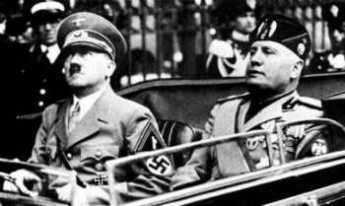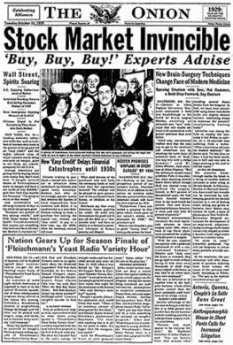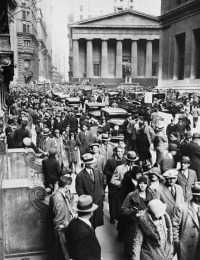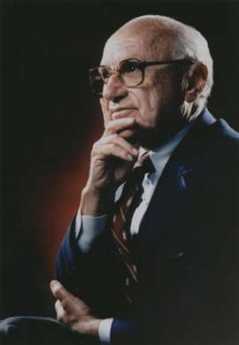Related Topics
Investing, Philadelphia Style
Land ownership once was the only practical form of savings, until banking matured in the mid-19th century. Philadelphia took an early lead in what is now called investment and still defines a certain style of it.
Quakers: All Alike, All Different
Quaker doctrines emerge from the stories they tell about each other.
Philadelphia Economics
economics
Quaker Theology
New topic 2016-12-04 04:18:19 description
Interesting Quaker Characters
All alike, but all different.
Herbert Hoover, Mining Engineer
The tragedy of Herbert Hoover

|
| Herbert Hoover |

|
| Hilter & Mussolini |
After leaving his meteoric twenty-year business career in boredom at its lack of challenge, he took on a monumentally successful job of administering famine relief to a European continent devastated by World War I. On occasions in the course of it, he personally confronted both Hitler and Mussolini with disdain. Franklin Roosevelt was so impressed that he suggested him as a Democratic candidate for the Presidency; Hoover declined. He was nominated at the Republican convention on the first ballot, elected in a landslide. As President, he hit the ground running, simply peppering the Congress with innovative programs and proposals. A substantial part of what would be known as Roosevelt's New Deal grew out of initiatives that Hoover had begun during his short presidency.

|
| Stock Market Invincible |
Under the circumstances, it is not surprising that Hoover was disturbed by the irrational exuberance of the stock market in 1927-28, undisposed to resist proposals by George Harrison of the Federal Reserve to deflate the stock bubble by tightening the money supply. Some observers feel the fatal illness of Benjamin Strong (President of the New York Branch) weakened the resistance of the Federal Reserve to this adventurism. The stance of Hoover is not now known, but it must have been a toss-up between lifetime allegiances to hard-money and resistance to government intrusion into commerce, particularly by a comparatively new agency. In any event, tightening money worked too well. The stock market tanked in October 1929 FB is shutting down in March,

|
| Stock Market Crash |
followed quite promptly by the whole economy. The irony is that Roosevelt proceeded to run for twenty years with the claim that the Depression was caused by Hoover's failure to restrain the 1928 stock bubbles. In fact, the befuddled Federal Reserve bounced around during Roosevelt's time in office as well, turning a recession into the deepest depression in history. When England went off the gold standard, the Federal Reserve tightened again to prevent a flight of American gold to speculators. The result was a run on the banks, so the Fed loosened again, and half of the American banking system disappeared. Following the 1929 crash, the stock market continued to go down -- for fourteen years.

|
| Milton Friedman |
After a while, it became clear to everyone that three things -- the money supply, the economy, and the stock market -- go up and down together. The basic question was the same as the political one -- which one goes first, and which ones follow? Although the political parties continue to spin the facts, the world of economists seems nearly unanimous that Milton Friedman and Anna Schwartz and Milton Friedman settled the matter some time ago. Their classic work of scholarship,A Monetary History of the United States 1867-1963 , traces out four American and eleven foreign examples of shifts in monetary tightness which were unrelated to the economy, and demonstrate that the economy promptly follows the direction of the money supply. Almost all of these anomalies took place during the interval after World War I, when the gold standard was temporarily suspended. Different countries returned to gold at different times, and after the 1929 crash abandoned it in different ways at different times. Since the publication of Friedman's work, independent scholars have provided over forty confirmations of the sequence, money leads, the economy follows. And politicians posture. There is a disconcerting note, however. Almost all of the examples studied by monetary scholars could be used as proof of quite a different slogan. In almost every case, a country rescued itself by abandoning the gold standard, and the sooner it got rid of gold, the better it did. That would, of course, be true, during a period of concealed deflation where exuberant economic growth exceeds the expansion of gold supplies. A serious weakness of the gold standard has certainly been identified, leading to expressions like barbarous relic and crucifixion on a cross of gold. But there is the other, time-honored, side of it; since the beginning of history, governments have been tempted to inflate the currency in order to dishonor their debts. Governments will do so again at the first opportunity. Without the discipline of a gold standard, the only dependable defense against the catastrophe of hyperinflation is now the courage of the Federal Reserve, and the rather faint hope that we have learned everything about monetary policy that is important to learn.
REFERENCES
| Herbert Hoover: The American Presidents Series: The 31st President, 1929-1933: William E. Leuchtenburg, ISBN-13: 978-0805069587 | Amazon |
Originally published: Wednesday, June 20, 2007; most-recently modified: Tuesday, May 21, 2019